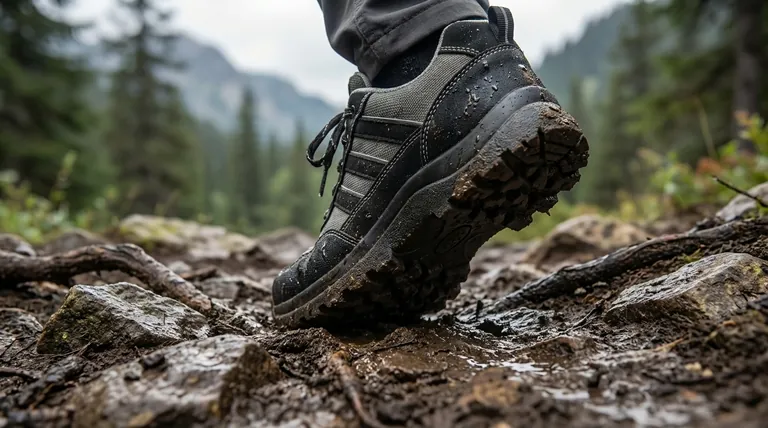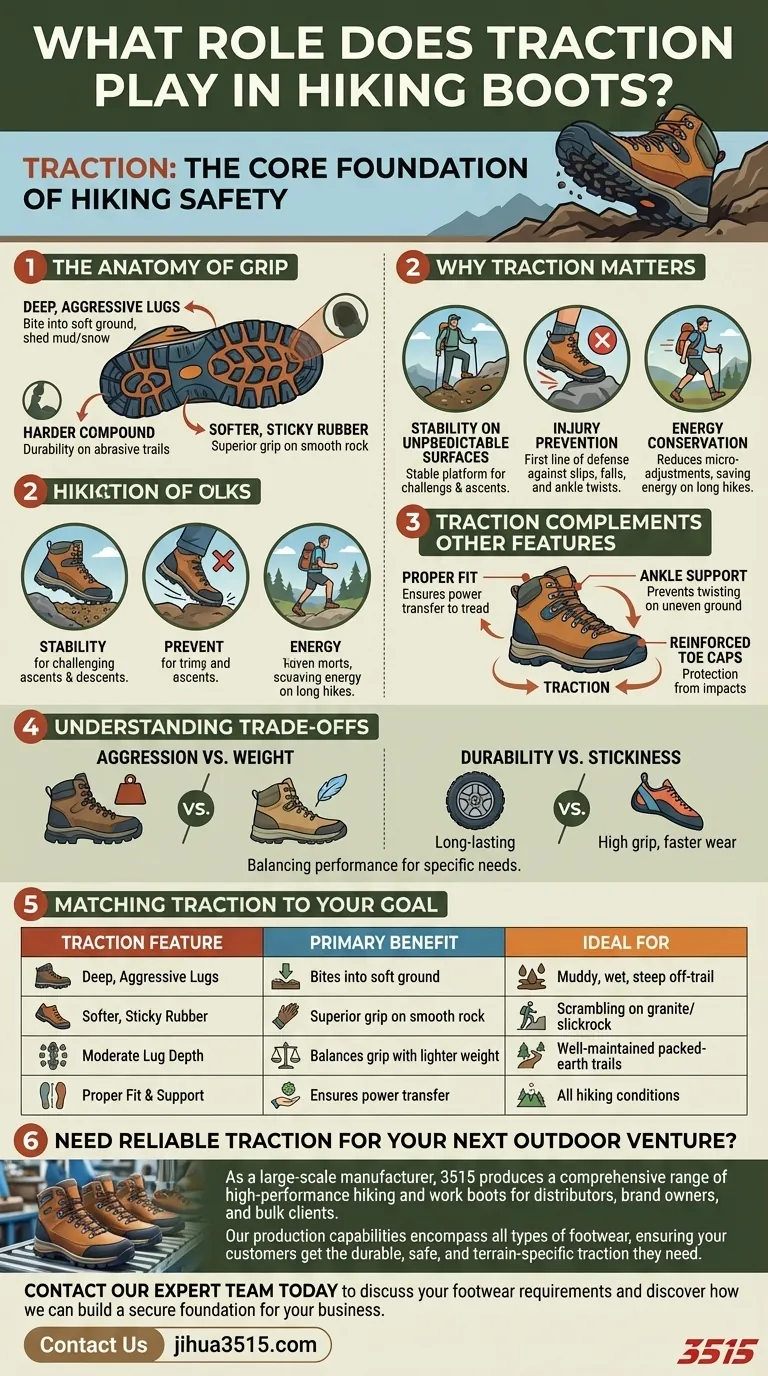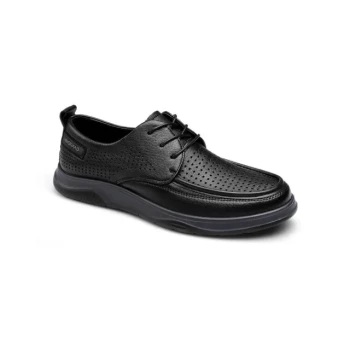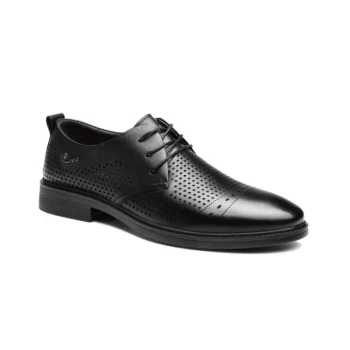At its core, traction is the single most important safety feature of a hiking boot. It is the boot's ability to grip the ground, providing the stability you need to navigate everything from loose gravel and slick mud to uneven rock faces. This grip is primarily determined by the outsole's tread pattern, particularly the depth and design of its "lugs," which prevent you from slipping and falling.
Traction is not just a feature; it is the fundamental connection between you and the trail. It ensures your energy translates into safe forward motion and provides the confidence needed to traverse challenging terrain securely.

Why Traction is the Foundation of Hiking Safety
Every other feature of a boot—support, waterproofing, comfort—is secondary to its ability to keep you upright. A failure in traction can lead directly to injury, making it the non-negotiable starting point for evaluating any hiking footwear.
The Anatomy of Grip
A boot's outsole creates traction through its material and design. Lugs are the deep, patterned indentations on the sole.
Deep, widely-spaced lugs are designed to bite into soft surfaces like mud or snow and shed debris effectively, preventing the sole from getting caked and losing its grip.
Softer, stickier rubber compounds excel at gripping smooth, dry rock, while harder compounds offer better durability for abrasive, high-mileage trails.
Stability on Unpredictable Surfaces
The primary role of traction is to provide a stable platform on ground that is constantly changing. This allows you to trust your footing, whether you're ascending a steep incline or carefully descending a slippery slope.
Good traction significantly reduces the micro-adjustments your muscles have to make to stay balanced, conserving energy and reducing fatigue over a long hike.
The Direct Line to Injury Prevention
A simple slip can result in a twisted ankle, a serious fall, or worse. An aggressive tread pattern is your first line of defense against these incidents, providing the reliable grip needed to prevent your feet from sliding out from under you.
How Traction Complements Other Boot Features
Traction does not work in isolation. Its effectiveness is directly influenced by the boot's overall design, from its internal fit to its ankle support. A weakness in one area can compromise the entire system.
Fit Determines Effectiveness
Even the best outsole is useless if your foot is sliding around inside the boot. A proper, snug fit ensures that the power from your leg is transferred directly to the tread, allowing the lugs to do their job. A poor fit negates the benefits of a high-traction sole.
Support and Traction Work in Tandem
Traction keeps the sole planted, while ankle support prevents your foot from twisting or rolling on uneven ground. A boot with excellent grip but poor ankle support is still a liability on rocky or off-camber trails.
Protection from the Trail
Features like reinforced toe caps protect your feet from impacts with rocks and roots. This protection allows you to move with more confidence, knowing that a stubbed toe won't compromise your stability.
Understanding the Trade-offs
Choosing the right level of traction always involves balancing competing priorities. The most aggressive tread is not always the best choice for every situation.
Aggression vs. Weight
Boots with deep lugs and thick outsoles offer superior traction but are almost always heavier. This added weight increases fatigue over long distances, making each step require more energy. For less demanding trails, a lighter boot with moderate traction is often a smarter choice.
Durability vs. Stickiness
The stickiest rubber compounds that provide phenomenal grip on rock surfaces tend to wear down much faster than harder rubber. You must choose between maximum performance for technical hikes and longevity for extended use on varied trails.
The Break-in Period
High-traction, supportive hiking boots are inherently more rigid than trail runners or regular shoes. They often require a break-in period to allow the materials to flex and conform to your foot, ensuring comfort on longer treks.
Matching Traction to Your Goal
Your intended use case is the most important factor in determining how much and what type of traction you need.
- If your primary focus is well-maintained, packed-earth trails: A boot with moderate lug depth is sufficient, allowing you to prioritize lower weight and flexibility for comfort.
- If your primary focus is muddy, wet, or steep off-trail routes: You need a boot with deep, aggressive, and widely-spaced lugs to ensure maximum grip and safety.
- If your primary focus is scrambling on granite or slickrock: Look for a boot with a softer, stickier rubber outsole that provides superior friction on smooth surfaces.
Ultimately, choosing the right traction is about selecting the right foundation for every step of your journey.
Summary Table:
| Traction Feature | Primary Benefit | Ideal For |
|---|---|---|
| Deep, Aggressive Lugs | Bites into soft ground; sheds mud/snow | Muddy, wet, and steep off-trail routes |
| Softer, Sticky Rubber | Superior grip on smooth, dry rock | Scrambling on granite or slickrock |
| Moderate Lug Depth | Balances grip with lighter weight | Well-maintained, packed-earth trails |
| Proper Fit & Support | Ensures power transfer; prevents ankle rolls | All hiking conditions for maximum safety |
Need reliable traction for your next outdoor venture?
As a large-scale manufacturer, 3515 produces a comprehensive range of high-performance hiking and work boots for distributors, brand owners, and bulk clients. Our production capabilities encompass all types of footwear, ensuring your customers get the durable, safe, and terrain-specific traction they need.
Contact our expert team today to discuss your footwear requirements and discover how we can build a secure foundation for your business.
Visual Guide

Related Products
- Durable Rubber-Soled Utility Shoes for Wholesale & Custom Brand Manufacturing
- Premium KPU Athletic Safety Shoes for Wholesale
- Wholesale Durable Breathable Safety Boots Custom OEM Manufacturer
- Custom Safety Shoe Manufacturer for Wholesale & OEM Brands
- Wholesale Leather Safety Boots with Customizable Protective Toe
People Also Ask
- What are the disadvantages of leather shoe soles? Key Limitations in Traction & Durability
- Which type of sole is better for premium sneakers and why? The Definitive Guide to Rubber Outsoles
- What is vulcanized rubber and why is it used in products? The Key to Durable, Flexible Footwear
- Why should we wear rubber soled shoes? Unlock Superior Safety and Durability
- What are rubber soled shoes? The Ultimate Guide to Durable, All-Weather Footwear



















